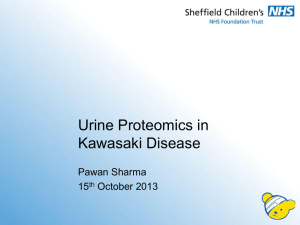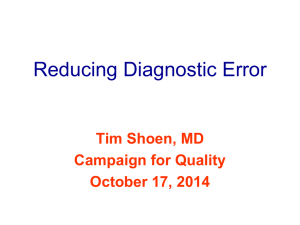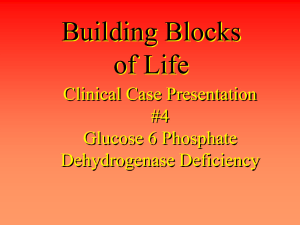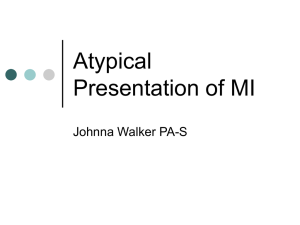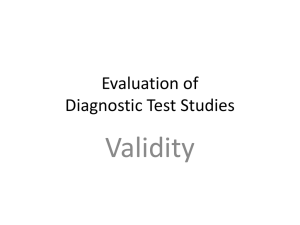floorcall2012 - Ob/Gyn Residents` Resources
advertisement
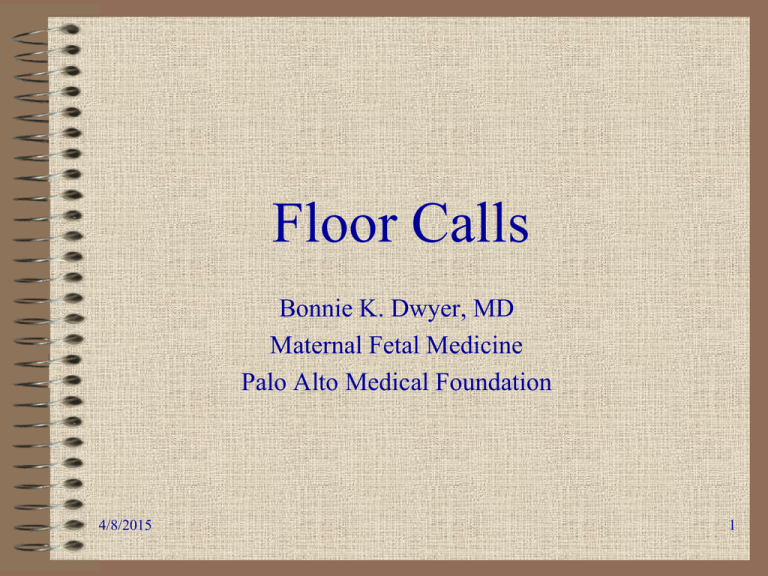
Floor Calls Bonnie K. Dwyer, MD Maternal Fetal Medicine Palo Alto Medical Foundation 4/8/2015 1 Introduction Words of Wisdom All of the answers lie in the Differential Diagnosis 4/8/2015 2 Topics • • • • • General Principles Fever- Intra Partum, Post Partum, General Low Urine Output Shortness of Breath Chest Pain 4/8/2015 3 General Principles • Does the patient need to be seen? – What are the patient’s vitals? – Is there an abnormal vital sign? – Is the patient symptomatic? • Does the patient need to be seen NOW? • Decide if you need help. 4/8/2015 4 General Principles • RUN vs. WALK – Run for any unstable vital sign – Go immediately for SOB /Chest Pain/Altered Mental Status 4/8/2015 5 General Principles • While running or walking – Think about the differential diagnosis – Think about what more information you will need to diagnose the problem – Decide on a plan of action 4/8/2015 6 General Principles • Be systematic in your thinking • Divide every problem into the following categories: – Differential diagnosis – Diagnostic plan – Treatment plan • Have a memorized or “Rote” diagnostic plan for each problem– you may later adjust it according to circumstance 4/8/2015 7 Fever The definition and management of fever is different depending on the setting Intra-partum Post-Partum General 4/8/2015 8 Fever: Intrapartum • Definition- Temperature ≥ 38 • Differential diagnosis – Chorioamnionitis – Exertional temperature elevation = “dehydration” – “Anesthesia related fever” = “dehydration” – Previously existing disease 4/8/2015 9 Fever: Intrapartum Diagnostic Plan • Physical exam – Exertional temperature elevation/ “anesthesia related fever”- includes only low grade temperatures, ie T< 38.0 (F100.4) – Research definition of “chorio” includes maternal fever and one more sign/symptom including maternal tachycardia (>100 bpm), fetal tachycardia, foul smelling lochia, or tender uterus – Clinical definition, “chorio” is T ≥ 38.0 (F100.4) 4/8/2015 10 Fever: Intrapartum Treatment • Diagnosis determines treatment – Exertional temperature elevation“Bolus” – Chorioamnionitis Ampicillin/Gentamicin during labor • PCN allergic-->Kefzol • If PCN anaphylaxis-->clinda/erythro if known GBS sensitivities available. Vanco if unknown. • If C/S is performed, add anaerobic coverage. Generally continued for 48 hours post-op. • Studies have shown that a single dose of antibiotic post vaginal delivery is as good as 24 hour doses. 4/8/2015 11 Fever: Post Partum • Whole different world! • Definition – Temperature greater than 38.5 X1, or – Temperature greater than 38.0 X2 after the first 24 hours post partum 4/8/2015 12 Fever: Post Partum Diagnosis • Differential Diagnosis (head to toe) – Mastitis – Atelectasis/Pneumonia—aspiration or hospital acquired – Endometritis – Pyelonephritis – Cellulitis/Wound Abscess – Vaginal hematoma/abscess – DVT/other thrombosis (septic pelvic thrombophlebitis) – Drugs and other usual suspects 4/8/2015 13 Fever: Post Partum Diagnosis • Endometritis– Uterine tenderness, foul smelling lochia – Absence of other obvious source – Know your bugs- On Creogs • Polymicrobial • 80% involve anaerobic organisms—peptostreptococci, bacteroides, etc. • Gram neg rods (E.coli), Gram pos cocci (GBS), etc. • Late endometritis—that is two weeks out may involve chlamydia—so add doxy to this regimen 4/8/2015 14 Fever: Post Partum Diagnostic Plan • • • • • • Physical Exam +/- U/A, Ucx +/- CBC +/- Blood cultures X2 +/- CXR +/- stool culture 4/8/2015 15 Fever: Post Partum Treatment • Diagnosis determines treatment type and length • If you start ABX before you send your cultures, you may be sorry • Assume endometritis if no other obvious source on exam 4/8/2015 16 Fever: Post Partum Treatment • Endometritis – This is the only bacterial infection that I know of for which you stop ABX when pt. is afebrile!! – Most will stop ABX when a pt. has been afebrile for 24-48 hours. If the pt. is s/p C/S—usually 48 hours. – Traditional antibiotics are “Triples,” but other broad spectrum antibiotics have been shown to be just as efficacious -Amp/Gent/Clinda—daily or thrice daily dosing -Clinda/Gent alone – recommended by ACOG -Zosyn, Unasyn, Cefotetan, Augmetin (po!!) 4/8/2015 17 Fever: Post Partum Endometritis • Blood cultures are done in a patient with endometritis to direct care if the patient NOT responding. • 10-20% of endometritis will have positive blood cultures. • 10-20% of endometritis will be secondary to inadequately covered enterococcus. • Although most cultures reveal a single organism, the infection is STILL polymicrobial! 4/8/2015 18 Fever: Post Partum Treatment • Pyelonephritis – Traditional treatment is Amp/gent, new studies show Cephalosporins also OK—Kefzol and Ceftriaxone are fine. – When afebrile X 24 hours, change to po’s, need 14 day course (if pt. not breast feeding, fluroquinolones ok, then only need 7 days) (+ blood cultures help with diagnosis, but do not alter treatment) NO MACRODANTIN for PYELO!!!! 4/8/2015 19 Fever: Post Partum Treatment • Mastitis- Typically T≥38.3 with systemic symptoms – Dicloxicillin or Keflex (traditional)—both OK for breast feeding and cover staph and strep. (Nafcillin or Kefzol if IV ABX needed.) – New emphasis to cover MRSA if recent hospitalization, consider clindamycin 300 mg qid – 10-14 day course – Breast feeding or pumping hastens recovery. – NSAIDS – Abscesses must be drained and can be diagnosed by ultrasound 4/8/2015 20 Fever: General • Rote – – – – – 4/8/2015 Physical Exam Blood culture X2 U/A, Ucx +/- CXR +/- stool cultures, ie C.diff 21 Fever: General Different World! • Definition- Temperature >38.5 (101.5) • Differential Diagnosis – – – – – – 4/8/2015 Infection Drug Thrombus- DVT-upper or lower extremity/PE Atelectasis Cancer Inflammatory disease/Vasculitis/Other 22 Fever: General Diagnostic Plan Individualize according to the patient. Think through anatomically: – – – – – Head: Sinusitis, Meningitis, otitis/pharyngitis Heart: Endocarditis Lungs: Pneumonia, pleural effusion Chest: Line infection Abdomen- abscess, pyelonephritis, biliary, infectious diarrhea, spontaneous or secondary bacterial peritonitis – Pelvis- PID/TOA, abscess – Back- Decubitus ulcers, rectal abscess – Extremities- cellulitis, septic thrombus, line infection, osteomyelitis 4/8/2015 23 Fever: General Diagnostic Plan • If the patient is immunocompromised, expand your differential diagnosis • If no obvious source of bacterial infection, think about viral causes of fever and the rest of the differential diagnosis 4/8/2015 24 Fever: General Treatment Plan • Diagnosis determines treatment type, dose, and duration. • Empiric treatment only if patient is septic or in danger of sepsis or life threatening complication. 4/8/2015 25 Fever: General Treatment Plan • Broad spectrum antibiotics – Know what category of bug each antibiotic covers, ie gram positive, negative, anaerobic, atypicals – Neutropenia: Each institution has its own hierarchy of Broad spectrum coverage. – Chronic illness or hospitalization: Add coverage for resistant gram positives with Vanco – If pt. in danger of dying or has a nosocomial infection, consider “double coverage” of gram negatives, specifically pseudomonas – Traditional Pseudomonal ABXs include: Gent/Tobra, Ceftaz, Cefepime, Zosyn/Timentin, Cipro, Imipenem/Meropenem, Aztreonam 4/8/2015 26 Low Urine Output Low urine output is not the problem, it signifies a problem Your goal is not to make the patient pee, but to figure out why she is not peeing 4/8/2015 27 Low Urine Output Definition • Low Urine Output– Less than 0.5cc/kg/hr (30-40cc/hr in a typical woman) • Oliguria- 400-500 cc/day • Anuria- Less than 50cc/day 4/8/2015 28 Low Urine Output • Differential Diagnosis – Intravascularly dry• True hypovolemia: intravascular depletion • Hypervolemia with intravascular depletion: 3rd spacing or low albumin states • “Intravascularly Dry”: low cardiac output, or low SVR (the kidney thinks the body is intravascularly dry) – Acute kidney injury (Acute renal failure) – Obstruction/Mechanical problem-outlet obstruction, ie FOLEY BLOCKADE, or hole in the bladder 4/8/2015 29 Low Urine Output Diagnostic Plan: Rote • On the phone- rule out easy things first – Does the pt. have a foley • If yes—flush foley • If no- Place foley and call me with the output • Determine volume status – Vital signs- HR, BP, O2 sat – Physicial exam- mucous membranes, neck veins, lungs, extremities 4/8/2015 30 Low Urine Output Diagnostic Plan- Extras Still can’t figure out volume status? Here are some tools: – Blood- BUN/Cr, Na+, HCO3 – Urine – sp. Gravitiy, urine Na+, urine creatinine (calculate your FeNa!!!) – CVP if you have a central line in place 4/8/2015 31 Low Urine Output Treatment • Intravasculary Dry: True Hypovolemia, including 3rd spacing and low albumin states – Give volume • NS or LR • Hesban or albumin – Avoid nephrotoxins, specifically NSAIDS, ACEI’s, contrast dye – Follow volume status on exam, O2 sat, I’s/O’s, daily wt.s very closely 4/8/2015 32 Low Urine Output Treatment • “Intravascularly Dry”- CHF, Cirrhosis, sepsis – Treatment is illness and circumstance specific – You have to make the kidney see more perfusion– ie increase cardiac output, increase SVR, and/or increase intravascular volume – Avoid Nephrotoxins as above 4/8/2015 33 Low Urine Output Treatment • Acute Kidney Injury (Acute renal failure) – Pre-renal azotemia- see Intravascularly dry above – Intra renal- in the hospital usually ATN • ATN– If secondary to pre-renal azotemia- fluid may help some, but beware of fluid overload – Avoid nephrotoxins- NSAIDS, ACEI’s, contrast dye, Aminoglycosides, Ampho B, Vanco • Interstitial Nephritis- avoid nephrotoxins- NSAIDS, PCN/Cephalosporins • Glomerulonephritis/Vascular lesion—much less common “hospital acquired problem” – Post-renal (ureteral/bladder/urethral obstruction)- see next 4/8/2015 34 Low Urine Output Treatment • ATN can either be oliguric (no pee) or nonoliguric (yes pee) – Lasix can convert oliguric to non-oliguric but will not change the renal prognosis – Lasix will only help you control volume status/electrolytes, NOT IMPROVE RENAL FUNCTION – ATN is managed supportively. Typical duration is 721 days, but may be months. A pt. may need dialysis for this time. 4/8/2015 35 Low Urine Output Treatment Again !!!! • Lasix is used to treat symptoms of volume overload– not low urine output • Remember, low urine output is not your problem, it is what is causing the low urine output that is your problem 4/8/2015 36 Low Urine Output Treatment • Obstruction/Mechanical -You can treat this by removing or circumventing the obstruction - After an obstruction is fixed, a pt. can develop “post-obstruction diuresis” which is an inappropriate diuresis– causing a pt. to become intravascularly dry if not monitored appropriately 4/8/2015 37 Shortness of Breath Differential Diagnosis: • LOW O2 SAT – Hypoxemia • Normal O2 SAT – – – – – – 4/8/2015 Airway obstruction Irritation of the pleura/lung parenchyma Metabolic- Acidosis, Sepsis Cardiac Ischemia equivalent Anemia Anxiety 38 Shortness of Breath Differential Diagnosis • Hypoxemia • • • • • • • • • 4/8/2015 Pulmonary edema- cardiogenic, non-cardiogenic Pneumonia Pulmonary embolism Atelectasis Pleural Effusion Pneumothorax Large Airway Obstruction Reactive Airway Disease/ COPD Restrictive Pulmonary Disease 39 SOB: Diagnostic Plan Rote • Current Vital signs, including a ROOM AIR SAT • Evaluate the patient immediately 4/8/2015 40 Diagnostic Rote Plan • Physical Exam- SICK vs. NOT SICK – – – – – – – 4/8/2015 Is the pt. in distress? Diaphoretic? Tachypneic? Altered Mental Status? Cardiac exam- Tachycardic? Neck Veins? Lung exam- Crackles? Wheeze? Abdomen- Pain? Extremities- Symmetric? DVT? 41 SOB: Diagnostic Plan Rote • If the pt. is sick- by virtue of vital signs or physical exam – CXR – EKG – Room Air ABG—if pt. too hypoxic to take off oxygen, an ABG on O2 is still useful to evaluate ventilation 4/8/2015 42 SOB: Diagnostic Plan Rote • CXR – Pulmonary infiltrates- Water, pus, or blood (pulmonary edema, pneumonia, diffuse alveolar hemorrhage) – Low lung volumes- poor breath, atelectasis, pleural effusion, pneumothorax – Large lung volumes COPD – Normal lung fields think PE – Heart size 4/8/2015 43 SOB: Diagnostic Plan Rote • EKG – – – – Rate Rhythm Evidence of ischemia Evidence of cardiac strain- via hypertrophy and axis – Evidence of PE 4/8/2015 44 SOB: Diagnostic Plan Rote ABG • Two components of respiratory distress – Oxygenation- Calculate the Aa gradient (on room air) – Ventilation- What is the pCO2? • If the pCO2 is low (<40)– this is appropriate for someone who is hypoxic and trying to compensate with respiratory rate • If the pCO2 is normal or high (near 40 or above)– Is normal appropriate?—if the pt. appears to be working hard to breathe, a nl or elevated pCO2 may represent resp. failure – This may be secondary to chronic pCO2 retention from COPD You can check the HCO3-, if elevated you’re OK 4/8/2015 45 SOB: Diagnostic Plan Extras • After the CXR, EKG, and ABG– you still may not know • For example: - Is the pulmonary edema cardiogenic or non-cardiogenic? - Is it a PE? • Consider other diagnostic tools, such as ECHO, V/Q scan, or CT angiogram 4/8/2015 46 SOB: Treatment • Diagnosis Determines Treatment 1. Supportive Care- know code status -hypoxemia- give O2, Keep Sat >92% -Ventilatory failure- BIPAP, intubation/ ventilator, narcan -Airway protection- Intubation 2. Treat underlying cause 4/8/2015 47 SOB: Treat Underlying Cause • Pulmonary edema- may need ECHO or SWAN to distinguish. These have different treatments and different prognoses. – Cardiogenic- Diurese, if pt. not in Sinus rhythmconvert or slow to nl rate • Ask yourself, why she decompensated • If pt. on Mg++--Turn off the Mg++, give Ca gluconcate • ?MI, arrythmia, fluid overload, valvular lesion, peripartum cardiomyopathy – Non-Cardiogenic- Diuresis may help • Otherwise known as acute lung injury (ALI) or ARDS– depending on extent • Treat underlying cause/Treatment primarily supportive 4/8/2015 48 SOB: Treat Underlying Cause • Pneumonia- Supportive care and ABX • Inpt.- 10- 14 day course of ABX, generally empiric treatment. – Community Acquired1. cefotaxime/ cetriaxone/unasyn AND macrolide (azithro/clarithro/erythro) OR 2. Fluoroquinolones (moxi, gemi, levofloxicin) – ICU1. beta lactam AND azithro 2. Beta lactam AND fluoroquinolone 3. Aztreonam AND fluoroquinolone – Aspiration- Zosyn (Clinda OK for outpt. Aspiration) 4/8/2015 49 SOB: Treat Underlying Cause • Pneumonia – Outpt. Community Acquired PNA – OK, if pt. <65, can take Po’s, has nl O2 sat, has capability of aquiring and taking ABX, has no comorbid illness, and is not pregnant – May be bacterial or viral or mycobacterial! – For bacterial: Azithro/doxy/fluoroquinolone OR Amoxicillin/Augmentin AND macrolide— 10-14 day course 4/8/2015 50 SOB: Treat Underlying Cause • Pulmonary Embolism- Think PE until proven otherwise – Risk Factors- ALL OF YOUR PTs.—any one who is pregnant, post-op, or has cancer – Work up may or may not show large Aa gradient, right axis / S1Q3T3 on EKG– pregnant women are especially tricky – D-dimer ELISA is great for screening (great negative predictive value)—but will not work in pt.s who are pregnant, post-op, or who have cancer!!! 4/8/2015 51 SOB: Treat Underlying Cause • Think PE until proven otherwise– especially with a negative CXR – Anticoagulate immediately if suspicion is high enough to get a definitive study (pretest probability>30%) – Lovenox 1mg/kg bid is treatment dose – Use unfractionated Heparin if worried about bleeding, if pt. has renal disease, or if pt. very obese – Do not feel bad for anticoagulating or getting a definitive study if the scan is negative—you still did the right thing 4/8/2015 52 SOB: Treat Underlying Cause • PE– the definitive study – CT angio vs. V/Q scan- The better test depends on the radiologist and the institution – At Stanford they are equally good – If the pt. has a Cr>1.5, choose V/Q – If the pt. has underlying lung parenchymal disease, choose CT angio 4/8/2015 53 SOB: Treat Underlying Cause • Asthma – Identify triggers and remove them – Albuterol immediately/add atrovent– if severe, may need epi – Long acting β-agonist – Steroid inhaler – If severe, systemic steroids—Solumedrol or Prednisone- most start with 30-60 mg qd and then do a rapid taper ****NOT all wheezes are “asthma”—wheeze can be heard with pulmonary edema 4/8/2015 54 Chest Pain Differential Diagnosis • Differential Diagnosis – Cardiac: Cardiac Ischemia/Pericarditis/Aortic Dissection – Pulmonary: Pulmonary Embolism/ Pneumonia/ Pulmonary edema/Pleuritis/Pneumothorax – Musculoskeletal: Muscle spasm/Costochondritis/ Herpes Zoster – GI: GERD/gastritis/PUD/Esophageal spasm/Pancreatitis/Biliary Disease – Pre-eclampsia – Anxiety—Diagnosis of exclusion 4/8/2015 55 Chest Pain: Rote Diagnostic Plan • Get vital signs from the nurse • Order an EKG over the phone—STAT • Think about a relevant DDx on your way!! 4/8/2015 56 Chest Pain: Rote Diagnostic Plan • Everybody gets an EKG And Usually a CXR 4/8/2015 57 Chest Pain: Rote Diagnostic Plan • When you arrive at the scene Rule out, Rule in: – You are basically taking a systematic approach— • Is it Deadly?—Call for help. • Is it Sick or Not Sick? • Is it Cardiac/Pulmonary/GI/other? 4/8/2015 58 Chest Pain: Rote Diagnostic Plan • Get the EKG, ask for the nurse to obtain an old one • Obtain vitals at bedside • Physical Exam – Is the pt. in distress? Diaphoretic? Tachypneic? – Is the pt.’s pain pleuritic? Reproducible with external pressure or limb movement? – Heart exam- rate, rhythm, JVP – Lungs- decreased breath sounds? Air movement? – Abdomen- Acute abdomen? – Extremities- Symmetric? 4/8/2015 59 Chest Pain: Rote Diagnostic Plan • History- As you are performing the exam, ask questions which relate to what you are examining. • These questions are ROTE and memorized. They do not have long answers. • Just interrupt the patient • If the pt. cannot answer– don’t waste time here. 4/8/2015 60 Chest Pain: Rote Diagnostic Plan • Heart exam- Pain=Pressure=Discomfort – – – – – – – – – 4/8/2015 Have you ever had anything like this before? CADRFs What were you doing when it started? Does it radiate to the arm, back, or neck? Is it assoc. with Nausea/ Diaphoresis/ SOB/palpitations? How long has it been present? Does it come and go, or is it constant? Out of 10, how bad is it? Does it get worse with a deep breath? 61 Chest Pain: Rote Diagnostic Plan • EKG- Obtain this as soon as possible, keep asking for it/help obtain it • You need an old EKG. Just make a rule—ALL PATIENTS OVER 50 OR WITH HISTORY OF DIABETES OR CARDIAC DISEASE GET A BASELINE EKG ON ADMISSION– or you will be sorry when she develops Chest Pain. • Strongly consider CXR 4/8/2015 62 Chest Pain: Diagnostic Plan • Use what you have learned in your evaluation- even if you are still waiting for studies. • Identify the organ system involvedCardiac/ Pulmonary/ GI/ Musculoskeletal/ other • This will help determine treatment 4/8/2015 63 Chest Pain: Treatment • Deadly?—Call for help- more Nurses, Senior Resident, Medicine, Cardiology, or Code? • Sick, Not Sick?-- Determine level of care. • Organ system?— Hedge your bets, begin to treat while you are figuring it out. 4/8/2015 64 Chest Pain: Treatment • Diagnosis Determines Treatment • Treatment Includes: – Treating Underlying Disease – Giving analgesics 4/8/2015 65 Chest Pain: Treatment • Think of BAD things first. • Consider treating these empirically, if they are low risk interventions. – Give O2 – Consider ASA– if no contraindications, will decrease mortality by 23-50%, if unstable angina or true MI-pt.s may chew it. – Consider Maalox/Nitroglycerin—for diagnosis/ treatment. – Turn off the Mg++ if it is on. 4/8/2015 66 Chest Pain: Cardiac Ischemia • Treatment– Oxygen – Morphine for pain – Nitroglycerin for pain- SL/paste/drip- typically 0.4 mg SL given q 5 min. X3, then another route should be used—hold for SBP<100—obtain post pain EKG – ASA to decrease risk of MI – Try to decrease myocardial work/increase O2 delivery – Consider beta blockade (with MI, decreases mortality by 1530%) – Consider transfusion if Hct<30 – Bring HR and BP to normal range 4/8/2015 67 Chest Pain: Cardiac Ischemia • Call Cards to help decide- +/- Lovenox, IIb/IIIa inhibitor, Cath lab, or TPA/thrombolysis– these are EKG dependent • “Time is Myocardium!” • Aortic Dissection is a contraindication to heparinization, etc. 4/8/2015 68 Chest Pain: Pleuritic • Treat underlying cause- ie. ABX, lasix, chest tube etc. • If you suspect PE >30% pre-test probability give lovenox—rule out aortic dissection first. • Treat with analgesics – Narcotics are good for air hunger—but careful if worried about drive to breathe – NSAIDs are good for pleurisy—careful if concerned about bleeding 4/8/2015 69 Chest Pain: GI • GERD/PUD—Maaolx good for acute discomfort, consider Pepcid, PPI – May need additional outpatient diagnostic and treatment follow up • GI disaster- perforated viscous, ischemic bowel, pancreatitis—individualize treatment 4/8/2015 70 Chest Pain: Other • Musculoskeletal- NSAIDs • Pre-eclampsia- True Abd. Pain implies severe disease and end organ complications • Anxiety- Reassurance, consider Benzo. – This is a true diagnosis of exclusion – If panic attacks– pt. may need outpt. diagnosis and treatment—SSRIs generally used 4/8/2015 71 Floor Calls THE END 4/8/2015 72 4/8/2015 73


